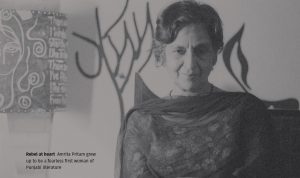 In 1935, a book of Punjabi verse called ‘Thandian Kirnan’ gave the world its first glimpse into the life and literature of a young girl, Amrit Kaur. Barely sixteen at the time of its publication, she wrote with a clarity, romanticism and fearlessness that far belied her tender age. Years later, she confessed that before her, there were only two known women writers in Punjabi and they wrote on religious themes. Her poems shocked, outraged and fascinated the literary world at that time. The critical acclaim and public fascination that followed grew with every subsequent work that she produced. The young romantic rebel grew up to be an even more fearless first woman of Punjabi literature, none other than Amrita Pritam. She was an iconic writer, whose works as well as her life, were a bold statement that redefined not just the Punjabi literary canon, but also created a new imagery on how Indian women perceived themselves.
In 1935, a book of Punjabi verse called ‘Thandian Kirnan’ gave the world its first glimpse into the life and literature of a young girl, Amrit Kaur. Barely sixteen at the time of its publication, she wrote with a clarity, romanticism and fearlessness that far belied her tender age. Years later, she confessed that before her, there were only two known women writers in Punjabi and they wrote on religious themes. Her poems shocked, outraged and fascinated the literary world at that time. The critical acclaim and public fascination that followed grew with every subsequent work that she produced. The young romantic rebel grew up to be an even more fearless first woman of Punjabi literature, none other than Amrita Pritam. She was an iconic writer, whose works as well as her life, were a bold statement that redefined not just the Punjabi literary canon, but also created a new imagery on how Indian women perceived themselves.
Despite the divergent paths taken by the two fragments of Punjab as part of two separate countries, some ties could not be entirely broken by Partition. Most notable would be the cultural ties that bind the two Punjabs: a rich poetic heritage and post-1947 literary output continued to unite the writers and poets of the divided land. No figure could be a better example of this process than Amrita Pritam. She enshrined the concept of Punjabi, the deep consciousness of being a Punjabi — a child of the land of the five rivers — irrespective of religious or caste affiliation. Hailed as a ‘Feminist before Feminists,’ Pritam was as much a non-conformist as she was non-confrontational. But first and foremost, she was a romantic. She bent the rules instead of breaking them but always remained true to herself. Though her infamous love life took over her public image in her later years, Pritam opened the doors for the plethora of women writers in Punjabi, as we see today.
Amrita’s identity began with what she called ‘one of nature’s secrets.’ Before her birth, two little girl students of her father prayed publicly in a gurudwara wishing for a girl child in the house of their Masterji. She was an only child of Kartar Singh and Raj Kaur, born on 31st August, 1919, in Gujranwala, in erstwhile undivided Punjab, now Pakistan. Her father was a school teacher and a Pracharak/Sikh religious preacher. The environment in her early home was deeply spiritual. While the religious constraints perplexed her, she inherited her love for literature from her father, a small-time poet who wrote under the pen name Piyush and also edited a Punjabi magazine. Bereft by her mother’s demise at an early age of eleven, she turned agnostic after witnessing the futility of prayer through her mother’s illness. Isolated by a disciplinarian father, Amrita found solace in her poems, each ‘a forbidden desire.’
The girl, wished for by two girls, grew up to give expression to the repressed desires and silent emotions of her ilk, countless women weighed down under the veil of exalted feminine virtues revered at that time. Her initial work consisted mainly of romantic poems though she gradually gravitated towards the Progressive Writers’ Movement. In 1944, in a poetry collection titled ‘Lok Peed’ (Anguish Of The Public), Amrita’s first social poetry emerged and she criticised the economy being depleted by the Second World War and the disastrous Bengal famine of 1943. Her increased involvement in social work in the mid-1940s, her working with the Lahore Radio Station for a brief period and her angst at the helplessness of the commoners, especially women, made her works around that time become more rebellious and socio-political in nature.
Pritam not only read history but also she witnessed history in the making. She became the part of that history during the partition of India in 1947, witnessing the killing of thousands of people, be it Hindus, Muslims or Sikhs. The events that happened at the time of Partition badly shattered the young Amrita. She depicted the sorrows, the pains and the helplessness of the times in her most famous poem ‘Aj aakhaan Waris Shah nu.’ She found a way out of her haunting reality by invoking the Sufi poet Waris Shah, calling on him to rise from his grave and give voice to the macabre horrors of a divided land. She wrote the poem on a train journey from Lahore to Dehradun in the aftermath of Partition. She also spoke of the women abducted during Partition and of the children they bore to unknown fathers. In her book ‘Pinjar’, she created the memorable character of Puro, a collective symbol of violence against women, loss of humanity and the ultimate surrender to existential fate.
After the Partition, Pritam moved to Delhi and started working for All India Radio for a period. She also presented a program called ‘Darpan’ on television. But her pet and most notable venture was Nagmani, a literary monthly. The magazine was a hallmark of Punjabi literature, a gateway that introduced many new voices and was known for its distinctive design, developed by her long-time companion Imroz. It ran for over three decades (1966-2003) and had a cult following. It was hailed for making authors out amateurs, be it a truck driver, a Dalit labourer or an army-man. The author of more than 100 books and later a Rajya Sabha member, Amrita Pritam produced poetry, fiction, biographies, essays, a collection of Punjabi folk songs and two autobiographical works that were translated into several Indian and foreign languages.
Amrita Pritam’s love-life and unconventional life choices always captured and rattled popular culture at the same time. Married at sixteen, Amrita endured an unhappy marriage for twenty-five years. While still married, Pritam nurtured an affection for noted lyricist Sahir Ludhianvi, an unrequited love which became as iconic as folklore. The relationship bore the iconic poem Sunehe, which won her the Sahitya Akademy Award in 1956, making her the first woman to receive the honour. Even after her divorce, still considered a taboo in certain sections, she equally celebrated her relationship with painter/artist Imroz. It is mirrored in her famous last poem ‘Main Tenu Phir Milangi.’ She revered every relationship in her life and the famous letters she wrote to Ludhianvi, Sajjad and Imroz are little gems known for their literary finesse. Pritam was conferred with countless awards and honours, including Bhartiya Jnanpith Award in 1982 for ‘Kagaj Te Canvas’ (Paper and Canvas).
The ever sceptical Khushwant Singh himself confessed to translating Pritam’s novel ‘Pinjar’ to English, in the hope of getting ‘a candid account of her love-life.’ Disappointed by her abstract loves, he dismissively remarked that the story of her life and love could fit on a postage stamp. In her signature irreverent style, she named her memoir ‘Raseedi Ticket’ (Postage Stamp). Amrita Pritam was the woman who taught us to celebrate women as imperfect mortals rather than put them on unrealistic pedestals. Through her writing, she has become the friend and confidante of women across continents. She stood for a humanity devoid of the barriers of caste, creed, boundaries or gender. Born ninety-nine years ago, Amrita Pritam is a classic modern woman and still the poster-girl for equality in today’s fragmented society.
LETTERS@TEHELKA.COM










